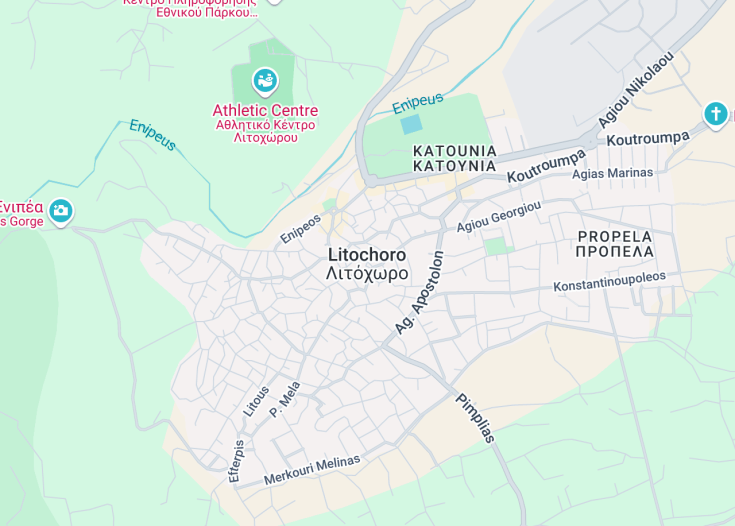Nestled at the base of the majestic Mount Olympus, Litochoro in Greece is a serene getaway that blends history with stunning natural landscapes. Known for its scenic beauty and rich mythological significance, this charming town serves as a gateway to exploring the mythical home of the Greek gods.
Litochoro offers enchanting walks through quaint cobblestone streets, alongside a host of outdoor activities ranging from hiking and mountaineering, to relaxing by the sea at nearby beaches.
Bring comfortable walking shoes and prepare for varied terrain as Litochoro is perfect for both leisurely strolls through the town’s historic centers and challenging hikes up Mount Olympus.
If you are planning to hike, consider visiting during spring or early autumn to enjoy the best weather conditions and a stunning natural palette of colors.
Top things to do & see in Litochoro
Select the following sights and activities to discover best tickets and tours available in Litochoro.
Litochoro: Gateway to the Greek Gods
| Country | Greece |
| Time in Litochoro | GMT+2 |
| Language spoken | Greek |
| Population | 7,010 (2021 census) |
| Currency | Euro (€, EUR) |
| Airports |
|
Situated at the base of Mount Olympus, Litochoro is not just a town but a celebrated part of Greek mythology and a modern-day hub for adventurers and scholars alike. Steeped in a history that blends myth with reality, Litochoro serves as the starting point for many who wish to explore the famed mountain, believed to be the home of the ancient Greek gods. Its picturesque landscapes and quaint village aesthetic make it a charming destination, while its proximity to the mountain provides ample opportunities for hiking, climbing, and appreciating natural scenery.
Throughout the ages, Litochoro has been revered not only for its mythological significance but also for its rich cultural tapestry. The town features Byzantine churches and monasteries, traditional Greek architecture, and a museum dedicated to the history of Mount Olympus, offering insights into the region’s significant archaeological findings and its impact on Greek culture. Additionally, the Olympus Festival, held annually, draws visitors from around the globe to partake in cultural performances, art exhibitions, and sporting events.
The economy of Litochoro is heavily influenced by tourism but also maintains a blend of traditional agricultural practices. The local cuisine, characterized by Mediterranean flavors, offers another layer of exploration for visitors, with numerous tavernas and cafes providing traditional Greek dishes made from locally sourced ingredients.
Whether you’re drawn to Litochoro by the lure of myth, the promise of adventure, or the beauty of its natural and cultural landscape, this town is a compelling destination that encapsulates the heart of Greece.
Where is Litochoro?
Litochoro is beautifully nestled at the foothills of Mount Olympus in the northern part of Greece, offering direct access to the legendary mountain.
Distances:
| Route | Distance by car | Time by car |
|---|---|---|
| Thessaloniki to Litochoro | 62 miles (100 km) | 1 hour 15 minutes |
| Athens to Litochoro | 279 miles (450 km) | 4 hours 30 minutes |
What is Litochoro famous for?
Litochoro is famous as the gateway to Mount Olympus, the mythical abode of theGreek gods, and is a favorite spot for mountaineers and nature lovers globally.
History
Ancient Period: Prehistory to 4th Century BCE
Litochoro, nestled at the foot of the majestic Mount Olympus, has a rich tapestry of history that starts in the mists of prehistory. The area was known to be inhabited by Thracian tribes, who were amongst the earliest settlers in this part of Greece. The strategic location of Litochoro, providing easy access to the Aegean Sea and fertile plains, made it a coveted site for these ancient peoples.
Roman and Byzantine Era: 4th Century BCE to 15th Century AD
With the expansion of the Roman Empire, Litochoro came under Roman influence, which continued into the Byzantine era. During this period, the town served as a strategic military and trading post. Byzantine influence is evident in the religious architecture and the introduction of Christianity, which left a lasting imprint on the local culture.
Ottoman Rule: 15th Century to 1912
The Ottoman conquest brought significant changes to the region. Litochoro was absorbed into the vast Ottoman Empire, leading to centuries of cultural and political influence. Despite the challenges of foreign rule, Litochoro maintained its cultural heritage, and many traditional customs and practices from this era are still observed in the town today.
Modern Era: 20th Century to Present
Following the liberation from Ottoman rule, Litochoro underwent a period of significant growth and development. In the 20th century, particularly post-World War II, the town developed into a modern community with improved infrastructure and facilities. Today, Litochoro is known not only for its historical and cultural significance but also as a gateway to exploring Mount Olympus, attracting tourists from around the globe interested in history, culture, and adventure.
Visit Litochoro
What to see and do in Litochoro, Greece
Visitors to Litochoro are greeted with a blend of historical charm and natural beauty. Key attractions include:
- The Archaeological Park of Dion: Explore the ruins of the ancient city sacred to Zeus, located just a short distance from Litochoro.
- Mount Olympus: Ideal for hiking enthusiasts, the mountain offers various trails ranging from easy walks to challenging climbs, with the Enipeas Gorge being a notable highlight.
- The Old Monastery of St. Dionysios: Nestled in the mountains, this religious site offers tranquility and beautifully preserved frescoes.
- The Maritime Museum of Litochoro: Delve into the town’s nautical history and its relationship with the Aegean Sea.
Enjoy local cuisine in the charming taverns, where traditional dishes are served with a view of the imposing Mount Olympus.
Festivals and Events in Litochoro
Litochoro is vibrant with cultural events throughout the year. The Olympus Marathon, a trail running event, takes place every June, celebrating the rich mythological heritage of the mountain.
Additionally, the Olympus Festival in July and August features a series of performances and concerts at the Ancient Theatre of Dion and in Litochoro, blending ancient drama with modern artistic expression.
Best time to visit Litochoro
The best time to visit Litochoro is from late spring to early autumn (May through September). During these months, the weather is pleasantly warm, perfect for hiking and exploring the nearby historical sites.
Is Litochoro worth visiting?
Litochoro is undoubtedly worth visiting for anyone interested in Greek mythology, ancient history, or seeking outdoor adventures. Its proximity to Mount Olympus offers unique opportunities for hiking and exploring nature, while the rich historical sites provide a deep dive into Greece’s cultural heritage.
Litochoro, with its picturesque settings and welcoming community, presents a perfect blend of adventure and cultural exploration that caters to a wide range of interests.









